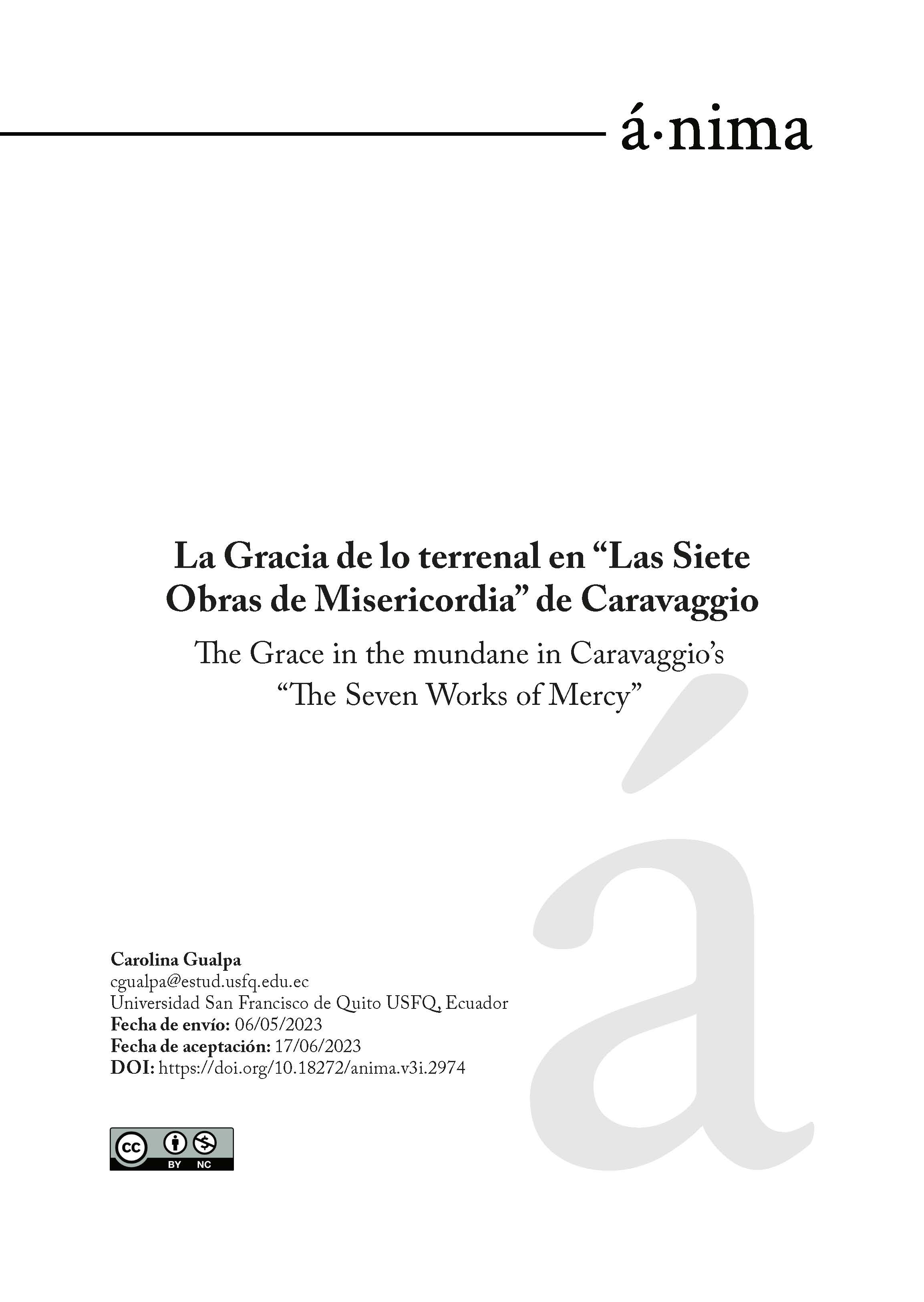The Grace in the mundane in Caravaggio’s "The Seven Works of Mercy"
DOI:
https://doi.org/10.18272/anima.v3i.2974Keywords:
Caravaggio, grace, naturalism, light, seven works of mercy, Giovanni Baglione, Giovanni Pietro Bellori, mysticism, counter-reformationAbstract
Caravaggio's naturalistic style caused critics such as Bellori and Baglione to question his artistic value; however, it is naturalism that makes Caravaggio's paintings come alive before the viewer and move them. In "The Seven Works of Mercy", the artist not only captures the reality of Neapolitan society, but shows the possibility of forgiveness and salvation, enabled thanks to the works of mercy. To better understand what was considered "good art" in the Italian Baroque, the original texts that Bellori and Baglione wrote regarding Caravaggio were used. Similarly, the painting was studied in parts in order to understand it in greater depth and to analyze the role of each character in the scene, and the light as a representation of Grace. Finally, it was concluded that the painting, by faithfully representing human nature, while giving it mysticism, gives the observer the hope that salvation is possible. Thus, the naturalism in this painting responds to the concerns of the baroque art of the Counter-Reformation, managing to move and persuade the observer.
Downloads
References
Alfaro, Juan. “Persona y Gracia.” Gregorianum, vol. 41, no. 1, 1960, pp. 5–29. JSTOR, www.jstor.org/stable/23571647.
Baglione, Giovanni. Le vite de' pittori, scultori et architetti. Roma: Heidelberger historische Bestände, 1642. Digital. https://doi.org/10.11588/diglit.26789#0007
Bellori, Giovanni Pietro. Le vite de' pittori, scultori, ed architetti moderni: Co' loro ritratti al Naturale . Roma: Heidelberger historische Bestände, 1728. Digital. https://doi.org/10.11588/diglit.11366#0150
Bühren, Ralf van. “Caravaggio’s ‘Seven Works of Mercy’in Naples. The relevance of art history to cultural journalism.” Church, Communication and Culture vol. 2, no. 1, 2017, pp. 63-87.
Castellotti, Marco Bona. La paradoja de Caravaggio. Madrid: Ediciones Encuentro, 2010. Digitalia, https://www-digitaliapublishing-com.ezbiblio.usfq.edu.ec/a/33649
González Prieto, Antonio, y Antonio Tello. Grandes maestros de la pintura: Caravaggio. Barcelona: Editorial Sol 90, S.L., 2006.
Pacciarotti, Giuseppe. La pintura barroca en Italia. Madrid: Ediciones Istmo, 2000.
Pavone, Mario Alberto. Prospettiva, no. 43, 1985, pp. 74–77. JSTOR, www.jstor.org/stable/24430706.
Puglisi, Catherine. Caravaggio. Londres: Phaidon, 1998.
Raben, Hans. “Bellori’s Art: The Taste and Distaste of a Seventeenth-Century Art Critic in Rome.” Simiolus: Netherlands Quarterly for the History of Art, vol. 32, no. 2/3, 2006, pp. 126–46. JSTOR, www.jstor.org/stable/20355327.
Schütze, Sebastian. Caravaggio: Obra completa. Taschen, Biblioteca Universalis, 2018.
Rodríguez, Sebastián. “Las Obras de Misericordia. Origen en las Sagradas Escrituras y desarrollo en la historia de la Iglesia. ” Ecclesia, vol. 30. no. 2, 2016, pp. 207-219.
Stagno, Laura. “Caravaggio a Genova: i rapporti con i Doria.” Caravaggio e la fuga. La pittura di paesaggio nelle ville Doria Pamphilj, 2010, pp. 23-29.

Downloads
Published
How to Cite
Issue
Section
License
Copyright (c) 2023 Carolina Gualpa

This work is licensed under a Creative Commons Attribution-NonCommercial 4.0 International License.
Los autores que publiquen en la revista aceptan los siguientes términos:
- Los autores conservarán sus derechos de autor y garantizarán a la revista el derecho de primera publicación de su obra, la cual estará simultáneamente sujeto a la Licencia de reconocimiento de Creative Commons que permite a terceros compartir la obra siempre que se indique su autor y su primera publicación esta revista.
- Los autores podrán adoptar otros acuerdos de licencia no exclusiva de distribución de la versión de la obra publicada, pudiendo de esa forma publicarla en un volumen monográfico o reproducirla de otras formas, siempre que se indique la publicación inicial en esta revista.
- Se permite y se recomienda a los autores difundir su obra a través de Internet:
- Antes del envío a la revista, los autores pueden depositar el manuscrito en archivos/repositorios de pre-publicaciones (preprint servers/repositories), incluyendo arXiv, bioRxiv, figshare, PeerJ Preprints, SSRN, entre otros, lo cual puede producir intercambios interesantes y aumentar las citas de la obra publicada (Véase El efecto del acceso abierto).
- Después del envío, se recomiendo que los autores depositen su artículo en su repositorio institucional, página web personal, o red social científica (como Zenodo, ResearchGate o Academia.edu).






